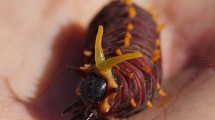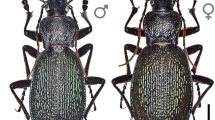Summary
The adaptation of defensive secretions to their target organisms was examined for the abdominal gland secretions ofBledius furcatus, B. spectabilis andB. arenarius. Therefore the target organisms of the secretion of theseBledius species (i.e. their predators) had to be identified. At the collection sites examined these were the earwigLabidura riparia, the antCataglyphis bicolor, the flyLispe candicans, different carabids of the generaPogonus, Dichirotrichus, Dyschirius, Bembidion andCalathus and the wading birdsHaematopus ostralegus andCalidris alba. The secretion of the abdominal glands contains the toxin ptoluquinone dissolved in eitherγ-dodecalactone and 1-undecene (B. furcatus andB. spectabilis) or in octanoic acid and octyloctanoate (B. arenarius). The ratio of these solvents is species-specific. Application experiments using some of the natural insect predators (L. riparia, C. bicolor, Pogonus, Di. gustavii, Dyschirius) revealed that these solvent ratios provided a more effective deterrent than other possible ratios. Thus by combining the solvents in certain ratios, the capability of cuticular penetration and therefore the effectiveness of the defensive secretions are adapted to their natural targets.
Similar content being viewed by others
References
Adis J (1979) Problems of interpreting arthropod sampling with pitfall traps. Zool Anz Jena 202:177–184
Araujo MJ (1973) Morphologie et histologie de la glande pygidiale défensive deBledius spectabilis Kr. (Staphylinidae, Oxytelinae). Comptes Rendues de l'Acad. de Sciences Paris 276 Série D:2713–2716
Baumann H, Kaib M (1993) Multifunktionelle Bedeutung des Giftdrüsensekretes der AmeiseMyrmicaria eumenoides. P 159. Kurzfassungen der Vorträge und Poster der DGaaE-Tagung, Jena 1993
Blum MS (1978) Biochemical defenses of insects. Pp 466–513in Rockstein M (ed.) Biochemistry of Insects. New York, San Francisco: Academic Press
Blum MS (1981) Chemical Defenses of Arthropods. New York: Academic Press
Burmeister F (1939) Biologie, Ökologie und Verbreitung der europäischen Käfer auf systematischer Grundlage: Adephaga, Caraboidea. Pp 62–69. Krefeld: Goecke & Evers
Crowson RA (1981) The biology of Coleoptera. London: Academic Press
Dettner K (1985) Chemische Ökologie, Evolutionstrends und Chemotaxonomie von Wehrdrüsensystemen bei Käfern (Coleoptera). Habilitationsschrift, TH Aachen
Dettner K (1987) Chemosystematics and evolution of beetle chemical defenses. Annu Rev Entomol 32:17–48
Dettner K (1991) Solvent-dependent variability of effectiveness of quinone-defensive systems of Oxytelinae beetles (Coleoptera: Staphylinidae). Entomol Gener 15:275–292
Dettner K (1993) Defensive secretions and exocrine glands in freeliving staphylinid beetles — their bearing on phylogeny (Coleoptera: Staphylinidae). Biochem Syst Ecol 19:291–303
Dettner K, Grümmer R (1986) Quasisynergism as evolutionary advance to increase repellency of beetle defensive secretions. Z Naturforsch 41c:493–496
Duffey SS (1976) Arthropod allomones: Chemical effronteries and antagonists. Proc XV Int Congr Entomol (1976):323–394
Eisner T, Meinwald J, Monro A, Ghent R (1961) Defence mechanisms of arthropods — I. The composition and function of the spray of the whipscorpion,Mastigoproctus giganteus (Lucas) (Arachnida, Pedipalpida). J Insect Physiol 6:272–298
Bezzel E (1993) Kompendium der Vögel Mitteleuropas, Passeres Singvögel. Pp 576–577. D-Wiesbaden: Aula-Verlag
Frommherz H (1966) Physikalisch-chemisches Rechnen in Wissenschaft und Technik. D-Weinheim: Verlag Chemie
Glutz U v. B, Bauer KM, Bezzel E (1975) Handbuch der Vögel Mitteleuropas 6, 1. D-Wiesbaden: Akademische Verlags-gesellschaft
Günther K, Hannemann HJ, Hieke F, Königsmann E, Schuhmann H (1989) Insekten, Urania Tierreich in sechs Bänden. 5. Aufl. Leipzig, Jena, Berlin: Urania Verlag
Herman LH (1986) Revision ofBledius. Part IV. Classification of species groups, phylogeny, natural history, and catalogue (Coleoptera, Staphylinidae, Oxytelinae). Bull Am Mus Nat Hist 184:1–368
Hinton HE (1944) Some general remarks on sub-social beetles, with notes on the biology of the staphylinid,Platystethus arenarius (Fourcroy). Proc R Ent Soc Lond (A) 19:115–128
Jacobs W, Renner M (1988) Biologie und Ökologie der Insekten. D-Stuttgart: Gustav Fischer Verlag
Krogerus R (1925) Studien über Lebensweise und Entwicklung einigerBledius-Arten. Acta Soc. Fauna Flora Fenn 56:1–27
Krogerus R (1932) Über die Ökologie und Verbreitung der Arthropoden der Triebsandgebiete an den Küsten Finnlands. Acta Zool Fennica 12:1–308
Larsen EB (1936) Biologische Studien über die tunnelgrabenden Käfer auf Skallingen. Vidansk Medd Fra Dansk Naturh Foren Kobenhavn 100:1–232
v. Lengerken H (1929) Die Salzkäfer der Nord- und Ostseeküste mit Berücksichtigung der angrenzenden Meere sowie des Mittelmeeres, des Schwarzen und des Kaspischen Meeres. Eine ökologisch-biologisch-geographische Studie. Zeitschr Wiss Zool 135:1–162
Lewis CT (1980) The penetration of cuticle by insecticides. Pp 367–400in Miller TA (ed.) Cuticle Techniques in Arthropods. New York, Heidelberg, Berlin: Springer Verlag
Paulian R (1942) Observations surBledius spectabilis Kraatz. Bull Lab Marit Dinard 24:62–72
Peschke K (1983) Defensive and pheromonal secretion of the tergal gland ofAleochara curtula II. Release and inhibition of male copulatory behavior. J Chem Ecol 9:13–31
Peschke K, Eisner T (1987) Defensive secretion of tenebrionid beetleBlaps mucronata: physical & chemical determinants of effectiveness. J Comp Physiol A 161:377–388
Pöch G, Juan H (1985) Allgemeine Pharmacodynamik. Stuttgart, New York: Thieme Verlag
Rudd GT (1835) Observations onHesperophilus arenarius and onZabrus gibbus. Entomol Mag 2:180–182
Sainte-Claire Deville J (1924) Kleinere Mitteilungen über dieDyschirius-Arten Europas. Koleopterol Rundsch 11:20–24
Steidle JLM (1991) Die Räuber der dreiBlediusartenBl. spectabilis, Bl. furcatus undBl. arenarius (Coleoptera, Staphylinidae). Jber Naturwiss Ver Wuppertal 44:64–68
Steidle JLM (1993) Das Abdominaldrüsensekret vonBledius (Coleoptera, Staphylinidae, Oxytelinae): seine Zusammensetzung, Funktion und Anpassung. Bayreuther Forum Ökologie 4:1–164
Wheeler JW, Happ GM, Araujo J, Pasteels JM (1972) Gamma-Dodecalactone from rove beetles. Tetrahedron Lett 46:4635–4638
Welling W, Paterson GD (1985) Toxicodynamics of insecticides. Pp 603–645in Kerkut GA, Gilbert LI (eds) Comprehensive Insect Physiology, Biochemistry & Pharmacology. Oxford: Pergamon Press
Whitman DW, Blum MS, Alsop DW (1990) Allomones: Chemicals for defence. Pp 289–351in Evans DL, Schmidt JO (eds) Insect Defences: Adaptive Mechanisms and Strategies of Prey and Predators. Albany/NY: State University of New York Press
v. Wingerden WKRE, Littel A, Boomsma JJ (1981) Strategies and population dynamics of arthropod species from coastal plains and green beaches. Pp 101–125in Smit CJ, Den Hollander J, v. Wingerden WKRE, Wolff WJ (eds) Final Report of the Section “Terrestrial Fauna” of the Wadden Sea Working Group 10
Witz BW (1990) Antipredator mechanism in arthropods: a twenty year literature survey. Fla Entomol 73:71–99
Wohlenberg E (1937) Die Wattenmeer-Lebensgemeinschaften im Königshafen von Sylt. Helgol Wiss Meeresunters 1:1–92
Wyatt TD (1986) How a subsocial beetle,Bledius spectabilis prevents flooding and anoxia in its burrow. Behav Ecol Sociobiol 19:323–331
Wyatt TD, Foster WA (1989a) Leaving home: predation and the dispersal of larvae from the maternal burrow ofBledius spectabilis, a subsocial intertidal beetle. Anim Behav 38:778–785
Wyatt TD, Foster WA (1989b) Parental care in the subsocial intertidal beetle,Bledius spectabilis, in relation to parasitism by the ichneumonid waspBarycnemis blediator. Behaviour 110:76–92
Author information
Authors and Affiliations
Rights and permissions
About this article
Cite this article
Steidle, J.L.M., Dettner, K. Quantitative composition of the defensive secretion ofBledius species (Coleoptera: Staphylinidae: Oxytelinae) is adapted to naturally occurring predators. Chemoecology 4, 63–71 (1993). https://doi.org/10.1007/BF01241675
Issue Date:
DOI: https://doi.org/10.1007/BF01241675




